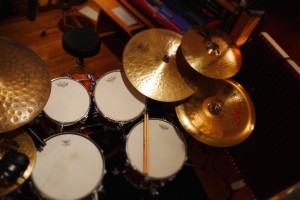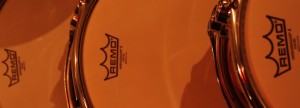In 1957, Remo was founded by Mr. Remo D. Belli, who himself was a well known drummer at the time. Right after 2nd world war, Belli experimented with various materials to create drum heads out of synthetic since heads had been made out of animal skin or pig-bladders. Hereby he encountered a material that had been used as a heat resistant film for nighttime reconnaissance flights at 2nd world war: Polyethylenterephthalat (PET) or better known under the name of Mylar.
This material was not only resistant against humidity and temperature but also capable of being covered with a fine, sand-like material, so that it could be played on with brushes. This way it was similar to natural heads that had been used up to that time. Since of its weather resistance, the legendary “ambassador weather king” series was born.
In the beginning it was mostly Rock Drummers who preferred the longer lasting synthetic heads whereas no less then a musician as Ringo Star from the Beatles put the Remo logo right on his Bass Drum and played a major part in contributing to the success of Remo in the Rock and Rock ´n Roll scene. Additionally more and more Jazz drummers, who preferred the sound of natural heads up to the early 60´s, were starting to use “ambassador weather king” heads.
For the last decades of the exceptional history of Remo, numerous types and models of heads – one or two plied – had been developed and characterized eras of musical styles and sounds. For example the two-plied Pin Stripe, Emperor, Black Dots or CS-heads of a Steve Gadd or Tony Williams, that had a rather bass-orientated sound or the Legacy or Renaissance series, that emphasize the jazzy – open sound.
There is no way to cover all models and combinations of the various types of Remo heads in this article. I suggest to check out the specialized community and the Remo website.
Besides of the fact that the history of a company such as Remo as mentioned above, always highly impressed me for the passion and product-identification, I have basically always played Remo. Since the beginning of the 90´s – my first Drummers Institute years – I feel a very close and warm-hearted relation to Gary Mann from Remo – I´ll never forget the mission to organize an 11” clear ambassador head for Simon Phillips series of workshops at D.I.
Up to today, Remo is supporting Drummers Institute and I can proudly say to be a Remo endorser myself. Thank you so much at Gary Man and Remo.
Besides of my close personal relation to Remo, it is for one simple reason, why I choose to play Remo: the sound – it always leads me back to Remo – no matter what other companies produce or either copy. Remo heads have a pure, clear, rich and warm sound that is in full balance with the overtones. Indeed, I am still experimenting and trying out to find the right sound for a particular production, recording session or gig that I am playing. Whether it is Rock, Jazz or an orchestral thing.
The reason for this unique sound of Remo heads is -with no doubt- a highly advanced and well thought process of production, that has been copied quite often but has never reached the standard of Remo.
To avoid repetition, I will not go into detail which heads I am using out of what reason, I hereby refer to the article “drums & heads” from this homepage.
Shortly I can sum up the following: I usually go for 1-ply-heads for Toms. However, since I love a warm but crisp sound and use birch, I use the Ambassador X series, which are 20% thicker than the average coated Ambassador heads. Double Ply heads – such as the coated Emperors – are nice to and certainly have their place, however, the attack and rebound fells a little to slow for me. For my Jazzdrums and Snares, I obviously go for – again – coated Ambassador or Vintage and for Bass Drum either Powerstroke 3 or coated Powerstroke.
Closing, I would like to mention, that Remo – next to drum sets, that unfortunately are not been produced any more – is also offering a wide variety of fantastic percussion instruments from the field of world music; wheater it is a Kanjira from South India, an Irish Bodhrán, Ocean Drums, Pandeiros, Rics, Talkin Drums, Taiko Drums, but also Djembes, Cuicas, Doumbeks, Timbales, Congas and many more. Remo uses special heads that had been developed for this purpose, such as Nuskyn, Fiberskin or the very impressive synthetic adaptation of the skin of an iguana for the Kanjira!
To round up the wide range of products, I have to point out the heads for the classical and marching area as well, that Remo is also offering in its program. For example the head for timpanies such as the Renaissance have reached a world wide standard.



